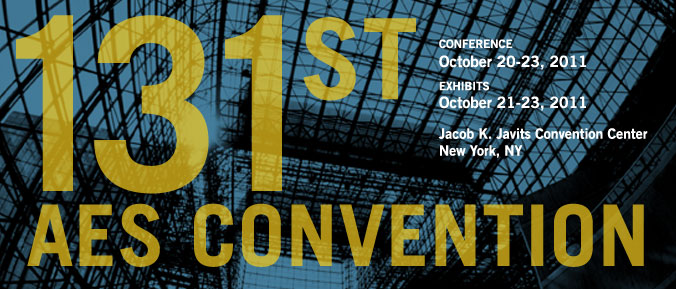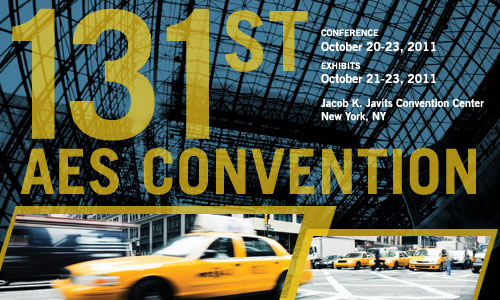
AES New York 2011
Product Design Session Details
Thursday, October 20, 9:00 am — 11:00 am (Room: 1E08)
PD1 - The Quietest Link—Better Noise and CMRR at Low Cost in Balanced Connections
Presenter:
Douglas Self
Abstract:
A balanced connection is usually considered a high-class connection compared with its unbalanced equivalent because of its proven ability to reject noise on the connection ground and other forms of interference. It is therefore rather unfortunate that the average balanced connection is some 14 dB noisier in terms of its own electronic noise. That difference is both clearly audible and hard to explain away to potential customers.
Another limitation of a balanced link is its finite Common-Mode-Rejection-Ratio, the figure that measures how well ground noise is rejected. Achieving a good CMRR is simple if you can use precision resistors but these are uneconomic for most applications.
This session looks at ways to improve both the noise performance and the CMRR of a balanced link without spending a lot of money.
Thursday, October 20, 4:30 pm — 6:30 pm (Room: 1E12)
PD2 - Is Your Equipment Design a Noise Problem Waiting to Happen?
Chair:
Bill Whitlock, Jensen Transformers
Abstract:
A design goal for all audio equipment is freedom from hum and buzz. But AC power normally creates a system environment of ground voltage differences. While a balanced interface is the first line of defense against this noise source, the balanced interface itself is very poorly understood by most engineers. This leads them to design balanced input circuits that perform impressively in the lab but have very poor noise rejection in real-world systems. To make matters worse, internal equipment grounding schemes are often thoughtlessly designed. Two common results are noise coupled via cable shield connections (the “Pin 1? problem) and the AC power cord (so-called “sensitive” equipment). These and other design pitfalls, and how to avoid them, are the focus of this class.
Friday, October 21, 9:00 am — 11:00 am (Room: 1E12)
PD3 - High Resolution Audio—A Networked Future?
Chair:
Vicki Melchior, Technical Consultant - MA, USA
Panelists:
John Dawson, Arcam - Cambridge, UK
Aaron Gelter, Harman International - UT, USA
Steven Harris, BridgeCo (SMSC) - UK
Abstract:
Though traditionally built on point-to-point connections, high res home audio and video systems are evolving toward full or partial networking. The tantalizing promise of internet access and server sourcing, disc as well as streamed A/V, and easy interconnection are driving more and more audio design in this direction. That includes multichannel audio, home theater, and even stereo. Nevertheless, networks in this market must integrate with traditional A/V and at the same time promote low jitter, high stability DAC clocks, together with appropriately low data delay, tight clock synch between devices, and excellent grounding and shielding.
The panel in this workshop discuss a number of promising standards and protocols (e.g., AVB, HDMI 1.4, Thunderbolt, plus standard uPNP/DLNA Ethernet, wi-fi), and consider their potential and promise relative to current forms of interfacing.
Friday, October 21, 11:30 am — 1:00 pm (Room: 1E12)
PD4 - Real-Time Audio Processing Capabilities of Microcontrollers and Application Processors
Chair:
Paul Beckmann
Abstract:
Microcontrollers and application processors have been steadily improving in performance to the point where they are being seriously considered by many audio product developers. Although they don't have all of the features found in traditional DSP processors, their performance has been boosted via DSP specific instructions and ever increasing clock speeds. This workshop carefully compares the architectures of microcontrollers and application processors with traditional DSPs with an eye towards their suitability for real-time audio processing. Measurements of the performance of individual low-level functions and complete signal chains on actual hardware are presented and we show what types of products can be realistically supported by each processor type.
Friday, October 21, 4:30 pm — 6:00 pm (Room: 1E12)
PD5 - Alternative Measurement Techniques
Chair:
Tom Kite, Audio Precision
Abstract:
Modern audio analyzers offer many approaches to taking measurements. Some approaches provide great speed and others high accuracy. Which is best for your circuit? Are steady tones appropriate for codecs? Are chirps appropriate for compressors? This session will compare and contrast alternative approaches such as multitones, chirps, and bursts to traditional techniques. Learn the benefits and pitfalls of various approaches. Get the answers and the understanding behind them.
Saturday, October 22, 9:00 am — 10:30 am (Room: 1E12)
PD6 - Design of a Dynamic Range Compressor
Chair:
Josh Reiss
Abstract:
Dynamic range compression, despite being one of the most widely used audio effects, is still poorly understood, and there is little formal knowledge and analysis of compressor design techniques. In this tutorial we describe several different approaches to digital dynamic range compressor design. Digital implementations of several classic analog approaches are given, as well as designs from recent literature and new approaches that address possible issues. Several design techniques are analyzed and compared, including RMS and peak-based approaches, feedforward and feedback designs, and linear and log domain level detection. We explain what makes the designs sound different, and provide distortion-based metrics to analyze their quality. Finally, we provide recommendations for high performance compressor design.
Saturday, October 22, 11:00 am — 12:30 pm (Room: 1E12)
PD7 - Building Analog in the 2010s
Presenter:
Bruce Hofer, Audio Precision, Inc.
Abstract:
The design of high performance analog circuits does not happen by accident. It requires very careful attention to detail, choice of components, topology, and physical layout. This session will explore a number of different factors that can limit analog performance along with some recommended solutions. Numerous examples will be presented including measurements and test results.
Saturday, October 22, 2:00 pm — 4:30 pm (Room: 1E12)
PD8 - Hot and Nonlinear—Loudspeakers at High Amplitudes
Chair:
Wolfgang Klippel, Klippel GmbH - Dresden Germany
Abstract:
Nonlinearities inherent in electro-dynamical transducer and the heating of the voice coil and magnetic system limit the acoustical output, generate distortion and other symptoms at high amplitudes. The large signal performance is the result of a deterministic process and predictable by lumped parameter models comprising nonlinear and thermal elements. The tutorial gives an introduction into the fundamentals, shows alternative measurement techniques and discusses the relationship between the physical causes and symptoms depending on the properties of the particular stimulus (test signal, music). Selection of meaningful measurements, the interpretation of the results and practical loudspeaker diagnostic is the main objective of the tutorial which is important for designing small and light transducers producing the desired output at high efficiency and reasonable cost.
Saturday, October 22, 5:00 pm — 6:30 pm (Room: 1E12)
PD9 - Specifying Class D Solutions
Chair:
Brian Oppegaard, SpeakerPower
Abstract:
Class D offers high-efficiency and light weight. Turnkey solutions and reference designs abound but how does one choose the most appropriate one? There is a lot more to it than price, power, size and weight. This panel of experts will discuss the considerations one needs to make.
Sunday, October 23, 11:00 am — 1:00 pm (Room: 1E12)
PD10 - An Overview of Audio System Grounding and Interfacing
Chair:
Bill Whitlock, Jensen Transformers
Abstract:
Equipment makers like to pretend the problems don’t exist, but this tutorial replaces hype and myth with insight and knowledge, revealing the true causes of system noise and ground loops. Unbalanced interfaces are exquisitely vulnerable to noise due to an intrinsic problem. Although balanced interfaces are theoretically noise-free, they’re widely misunderstood by equipment designers, which often results in inadequate noise rejection in real-world systems. Because of a widespread design error, some equipment has a built-in noise problem. Simple, no-test-equipment, troubleshooting methods can pinpoint the location and cause of system noise. Ground isolators in the signal path solve the fundamental noise coupling problems. Also discussed are unbalanced to balanced connections, RF interference, and power line treatments. Some widely used “cures” are both illegal and deadly.
Sunday, October 23, 2:30 pm — 4:00 pm (Room: 1E12)
PD11 - Networked Audio Gizmos—Ethernet Audio Today and Tomorrow
Chair:
Steve Macatee, Rane Corporation
Panelists:
Bradford Benn, Crown International
Hardy Martin, Innovative Electronic Designs, Inc.
Chris Pane, Lab X Technologies (The Ethernet AVB Camp)
Abstract:
What problems are integrators faced with when setting up many different Ethernet devices on the same network? Is your design approach causing the problem or a victim of someone else’s? What obstacles deter configuration software and devices from establishing and maintaining communications on simple and complex Ethernet networks? The pros and cons of UDP vs TCP protocols for control and metering messages. How to get through routers, VPNs, and blocked ports. Is your design approach making the IT department your friend or foe? Can you make it easier for customers to get through their firewall(s)? What challenges do older products encounter on ever-changing, modern networks? Can one product’s communications method interfere with already established device communications? Will Ethernet AVB finally solve all problems known to man?

